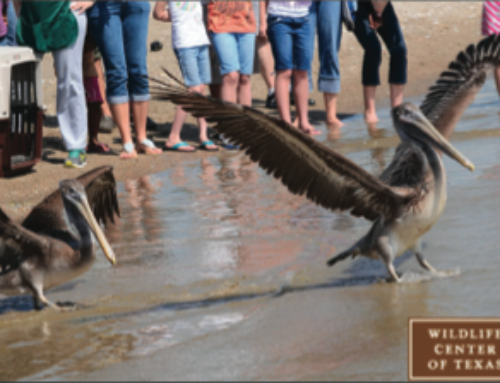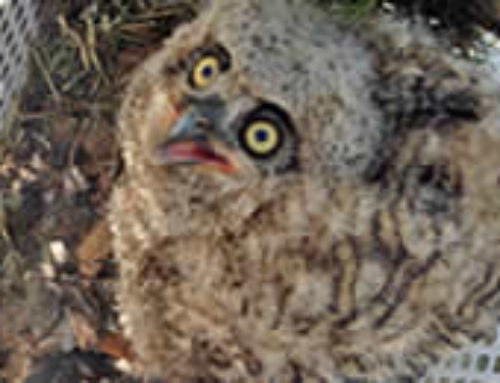 For the last seven years, Wildlife Rehab and Education has been working with biologists Woody Woodrow with the U S Fish and Wildlife Service, Sharon Schmalz Director of the WR&E Wildlife Center and Dr. Ray Telfair a well known ornithologist and former Texas Parks and Wildlife colleague of Woody’s study the movement patterns in Yellow-crowned Night Herons. While these herons are a common sight in our ditches and neighborhoods, biologists don’t know too much about their movement patterns. They are high tree nesters and so banding them in the nest is extremely difficult. Each year WRE typically releases a considerable number of these herons. To Sharon and Woody, this seemed like an opportunity to band some birds and hopefully collect some information about the birds.
For the last seven years, Wildlife Rehab and Education has been working with biologists Woody Woodrow with the U S Fish and Wildlife Service, Sharon Schmalz Director of the WR&E Wildlife Center and Dr. Ray Telfair a well known ornithologist and former Texas Parks and Wildlife colleague of Woody’s study the movement patterns in Yellow-crowned Night Herons. While these herons are a common sight in our ditches and neighborhoods, biologists don’t know too much about their movement patterns. They are high tree nesters and so banding them in the nest is extremely difficult. Each year WRE typically releases a considerable number of these herons. To Sharon and Woody, this seemed like an opportunity to band some birds and hopefully collect some information about the birds.
 With the help of Dr. Ray Telfair banding and marking began in 2003. Additional research is being conducted by Dr. Heatley from Texas A&M University’s College of Veterinary Medicine. She is using small blood samples collected from healthy birds to determine normal electrolytes and other blood parameters in these herons. Thus when ill or injured herons are, these values will help rehabilitators, veterinarians and biologists determine appropriate treatment and to diagnose diseases or toxicoses.
With the help of Dr. Ray Telfair banding and marking began in 2003. Additional research is being conducted by Dr. Heatley from Texas A&M University’s College of Veterinary Medicine. She is using small blood samples collected from healthy birds to determine normal electrolytes and other blood parameters in these herons. Thus when ill or injured herons are, these values will help rehabilitators, veterinarians and biologists determine appropriate treatment and to diagnose diseases or toxicoses.
Before the banding began, Sharon had started to apply hacking techniques used with raptors with the herons. This allowed the birds to transition from a captive state to living without her assistance. When the birds are ready to go, the team bands them with a USFWS number specific aluminum band. In order to track observations of the birds, a nylon flag is also placed with the band above the bird’s wrist (what we think of as their knees). The bands are typically aluminum gray but the flags have a color code so that the team can determine what year it was banded when observations are reported.
Woody Woodrow and Faith Weeks a WR&E volunteer help Sharon Schmalz, Director of WR&E band the Yellow Crowned Night Herons that were prepared for release in her 60 foot flight cage. Each year between 25 and 45 Yellow-crowned Night Herons that have been rehabilitated by WR&E are banded and released. Fish are set out each evening until the herons are self-sufficient. It is smelly but rewarding work.
If you see a banded or flagged bird, please notify the Bird Banding Laboratory in Patuxent, Maryland. Their number is 1 (800) 327-BAND. You can also go to their website and report it online at: http://www.pwrc.usgs.gov/bbl/ You can also contact Woody Woodrow at woody_woodrow@fws.gov or by calling (281) 286-8282.
Finding banded birds is very uncommon. Only about 1% of banded birds are recovered. There are situations however where banded birds are recovered more frequently than normal. WR&E Oiled Wildlife Response members have found birds that they had rescued from a previous oil spill during another oil spill years later. Woody and Sharon have observed banded herons banded several years prior to the sighting. The Wildlife Center was excited when a banded Peregrine Falcon was brought in for treatment. Tracing the band we discovered that “Samson” was the male of a pair of Peregrine Falcons that had were web-celebrities. His story is detailed in this newsletter.
Recovery of banded birds has provided astonishing information. An Arctic Tern banded as a chick in England made it to Melbourne, Australia three months later and over 14,000 miles. The Manx Shearwater banded as an adult about five years old was recaptured 50 years later and is the oldest known wild bird. A banded mourning dove was recovered 31 years later and it is the 10th oldest banded bird for the US. The oldest record for the yellow-crowned night heron is 6 years and 3 months for a bird in Mexico that had been shot, so they can live longer than that. Hopefully, our team will beat that record!
With the exception of rehabilitated birds, researchers must go into the field and either trap/snare birds or band birds before they fledge. Banding birds that are near fledging age is possible because the leg diameter doesn’t change much, in some species the leg diameter actually decreases with maturity. Banding herons in a rookery is a messy job as Mike Rowe of “Dirty Jobs” found out when he accompanied researchers to “Vomit Island” (an island in Lake Erie). Apparently, when herons feel threatened they will regurgitate half digested fish onto the offending party. Yuck! At WRE, we band before dinner.






I should really get my spouse to comment on this – he banded albatross in ‘old’ Hawaii (700 nautical miles away from the big island) and knew of a bird on Laysan banded 60 years ago as an adult!